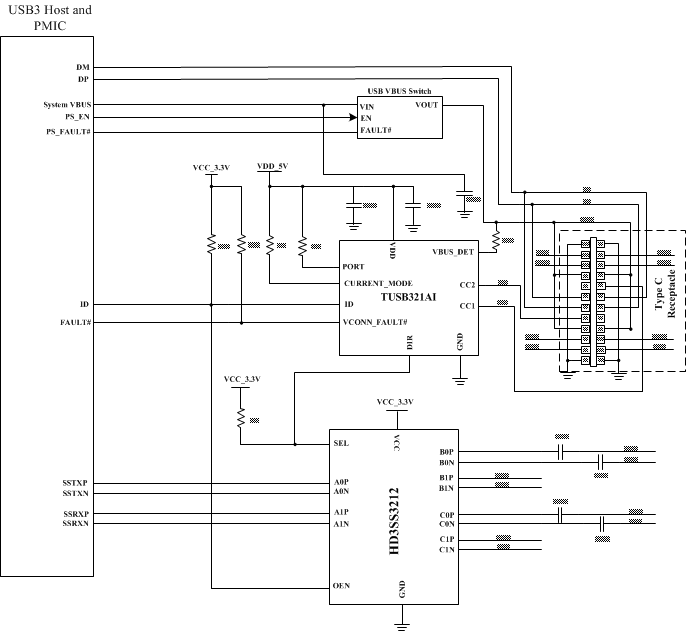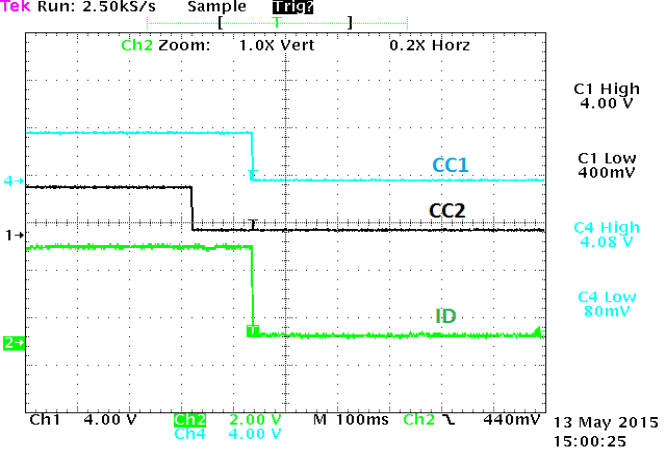ZHCSEB5 October 2015 TUSB321AI
PRODUCTION DATA.
8 Application and Implementation
NOTE
Information in the following applications sections is not part of the TI component specification, and TI does not warrant its accuracy or completeness. TI’s customers are responsible for determining suitability of components for their purposes. Customers should validate and test their design implementation to confirm system functionality.
8.1 Application Information
The TUSB321AI device is a Type-C configuration channel logic and port controller. The TUSB321AI device can detect when a Type-C device is attached, what type of device is attached, the orientation of the cable, and power capabilities (both detection and broadcast). The TUSB321AI device can be used in a source application (DFP) or in a sink application (UFP).
8.2 Typical Application
8.2.1 DFP Mode
Figure 3 shows the TUSB321AI device configured as a DFP.
 Figure 3. DFP Mode Schematic
Figure 3. DFP Mode Schematic
8.2.1.1 Design Requirements
For this design example, use the parameters listed in Table 4:
Table 4. Design Requirements for DFP Mode
| DESIGN PARAMETER | VALUE |
|---|---|
| VDD (4.5 V to 5.5 V) | 5 V |
| Type-C port type (UFP, DFP, or DRP) | DFP PORT pin is pulled up |
| Advertised Type-C Current (Default, 1.5 A, 3 A) | 3 A |
| VCONN Support | Yes |
8.2.1.2 Detailed Design Procedure
The TUSB321AI device supports a VDD in the range of 4.5 to 5.5 V. In this particular case, VDD is set to 5 V. A 100-nF capacitor is placed near VDD. Also, a 100 µF is used to meet the USB Type-C bulk capacitance requirement of 10 µF to 220 µF.
The TUSB321AI current advertisement is determined by the state of the CURRENT_MODE pin. In this particular example, 3 A advertisement is desired so the CURRENT_MODE pin is pulled high to VDD through 10-kΩ resistor.
The DIR pin is used to control the MUX for connecting the USB3 SS signals to the appropriate pins on the USB Type-C receptacle. In this particular case, a HD3SS3212 is used as the MUX. In order to minimize crossing in routing the USB 3.1 SS signals to the USB Type C connector, the connection of CC1 and CC2 to the TUSB321AI is swapped.
The Type-C port mode is determined by the state of the PORT pin. When the PORT pin is pulled high, the TUSB321AI device is in DFP mode.
The VBUS_DET pin must be connected through a 900-kΩ resistor to VBUS on the Type-C that is connected. This large resistor is required to protect the TUSB321AI device from large VBUS voltage that is possible in present day systems. This resistor along with internal pulldown keeps the voltage observed by the TUSB321AI device in the recommended range.
The USB3.1 specification requires the bulk capacitance on VBUS based on UFP or DFP. When operating the TUSB321AI device in a DFP mode, a bulk capacitance of at least 120 µF is required. In this particular case, a 150-µF capacitor was chosen.
8.2.1.3 Application Curve
 Figure 4. Application Curve for DFP Mode
Figure 4. Application Curve for DFP Mode
8.3 Initialization Set Up
The general power-up sequence for the TUSB321AI device is as follows:
- System is powered off (device has no VDD). The TUSB321AI device is configured internally in UFP mode with Rds on CC pins.
- VDD ramps – POR circuit.
- The TUSB321AI device enters unattached mode and determines the voltage level from the PORT pin. This determines the mode in which the TUSB321AI device operates (DFP, UFP, DRP).
- The TUSB321AI device monitors the CC pins as a DFP and VBUS for attach as a UFP.
- The TUSB321AI device enters active mode when attach has been successfully detected.